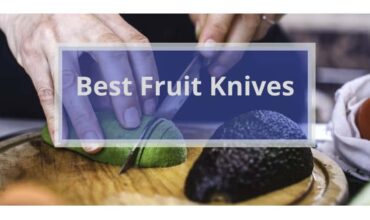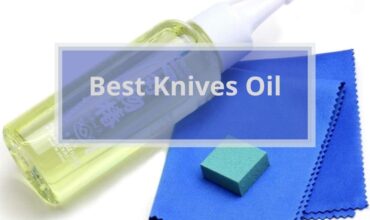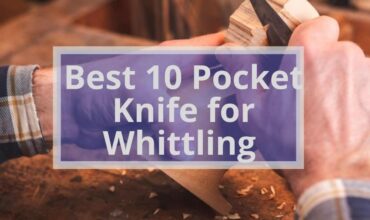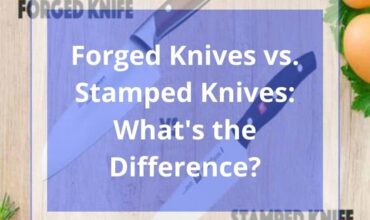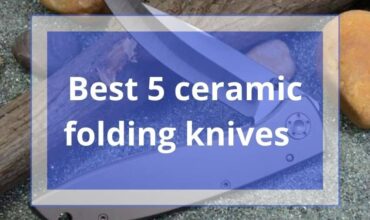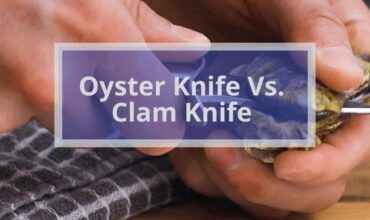There are different types of knives with a wide range of applications. And every single knife got its own job.
A chef’s knife is used for the big chopping tasks, a paring knife is used for slicing smaller veggies and fruits, A boning knife is used for or removing the bones of poultry, meat, and fish. and there are some more weird knives for weird uses!
That’s why it is necessary to know what are the different types of knives to learn how to pick the right one for each task. and that’s what we will be showing you in the next few lines.
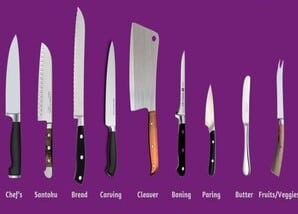
The basic types of kitchen knives
This section covers the most important and commonly used varieties of kitchen knives. Which no chef, beginner or professional, should ever be missing.
Chef’s knife
Aka cook’s knife. It is the most important kitchen knife in your kitchen. Let me tell you more about it.
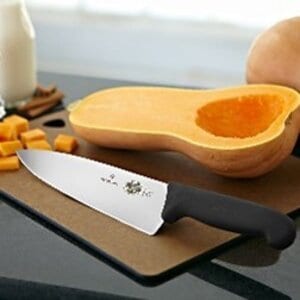
A chef’s knife has a wide blade that curves upward to the tip, to make it rock back and forth for quick mincing.
It ranges from 6 and 12 inches long. And the cook chooses according to his hands!
Although the finest kitchen knife is usually a forged knife, a chef’s knife can be a stamped knife.
It usually has a full tang, which means the bottom section of the knife blade runs the entire length and width of the handles.
In comparison to a partial tang, this kitchen knife type offers more stability and longevity.
The chef’s knife determines the sharpening technique. but anyways your kitchen knife sharpener should also work with all your knives.
Read more, 5 Best Fruit Knives Review
What is the use of a chef’s knife?
It will let you slice and dice food on your cutting board with a rocking motion, because of its slightly curved tip.
The large heal portion allows it to resist the high pressure of complex cooking tasks. which will make cutting hard vegetables like onions, potatoes, and carrots much easier.
Which is the best length for a chef’s knife?
A chef’s knife with an 8-inch blade is the most popular tool. But we have to mention that the longer blade of a 10-inch edge can slice bigger amounts of food at a time.
What is a chef’s Japanese knife?

A Japanese-style chef’s knife is lighter and thinner than a German-style knife. It is more versatile and capable of precise slicing.
The slimmer knife blade also tends to be extremely sharp.
To be honest, a Japanese-style chef’s knife is not ideal for slicing chicken. or cutting through an acorn squash. why? because it lacks the robust.
Utility knife
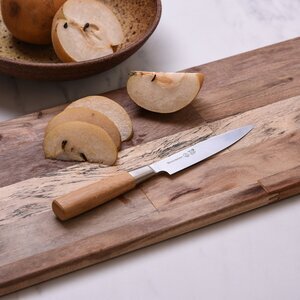
A utility knife is just like a chef knife, except for being smaller and thinner. Specific utility knives feature a sharp tip that curves up toward the spine.
Noting that it should be 4 and 7 inches in length to chop food that is too tiny for a chef’s knife.
Smaller utility knives are ideal for peeling and chopping tiny fruits and vegetables. While larger utility knives are suitable for heavier chopping tasks or general cutting purposes.
The narrow knife blade and small tip make it a perfect tool for thinner slicing, trimming, and filleting.
What is the use of a utility knife?
It is awesome for cutting smaller fruits and vegetables, such as shallots.
So, if your chef’s knife is too large for the job, a utility knife will perfectly get the job done.
Paring knife
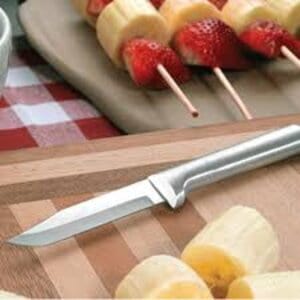
A paring knife is a small knife with a short blade used for detailed cutting, peeling, mincing, dicing, and taking away seeds from fruit and vegetables. Its edges are simple, precise, and sharp.
It is worth mentioning that a paring knife is a must-have tool if you enjoy making garnishes for your food and drinks.
These are the most common paring knife styles, spear point, sheep’s foot, and bird’s beak. And all of them are named according to the tip’s shape.
What is the best length for a paring knife?
A paring knife is typically 3.5-4 inches long with a sharp tip, and you can also find some with 2.5 inches.
Bread knife

A bread knife features a long, even blade with a sharp serrated edge, like a saw.
Its length varies from 7 to 10 inches. And features a tiny and straight blade or serrated knife with large “teeth”.
These kinds of serrated knives are designed to deal with softer textures and big chunks of food.
What is the use of a bread knife?
Bread knives are ideal for cutting crusty bread, baguettes, bagels, and bread rolls. Because of the grooved edge serrated blade that lets the chef slice through softer materials without crushing them out of shape.
Bread knives can also cut through soft and fluffy textures without forcing the air out of the sponge or ruining the overall form. (check our list of the best bread knives).
Kitchen shears
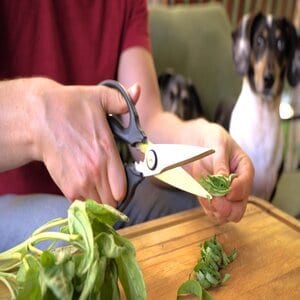
Kitchen shears are a pair of scissors with broad, robust blades used to cut through a variety of foods.
The blades of such shears are often thin and delicate.
What is the use of a kitchen shear?
Shears are used for snipping herbs, sectioning poultry, prepping shrimp, octopus, slicing pizza, and many other cutting jobs.
Some shears include many blades for cutting green onions and other herbs quickly.
What is the best length of a kitchen shear?
Shears typically feature up to 6″ blades with an oversized and oval bottom handle. While some kitchen scissors have shorter blades of 4-5″ to provide more leverage.
The different types of knives for preparing meat
Big chunks of beef, delicate lamb joints, and chicken usually need skillful preparations and specialized utensils. And any master chef can tell the difference between a boning knife and a cleaver.
It is time for you to learn the differences too. And learn the usage of every meat knife.
Carving knife & Slicing knife
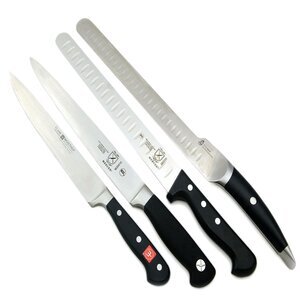
A carving knife is one of the most extended cooking blades in the kitchen. It is a long, slim blade with a sharp point.
It causes less friction because of its tiny width. Giving neater, and more even slices.
A slicing knife is used to cut thin slices of meat, chicken, lamb, or beef, fruits, and vegetables. It has a more adjustable blade than a carving knife.
What is the use of both a carving knife and a slicing knife?
They can be used to cut through larger fruits and vegetables, such as melons and courgettes.
The long, slender blades are made for cutting cakes, because they can make precise slices in a single smooth motion.
What is the best length for a carving knife/ slicing knife?
Get a carving knife with a blade that is at least 8 inches long, while for a slicing knife, a 10-inch blade is the best.
Cleaver/butcher knife
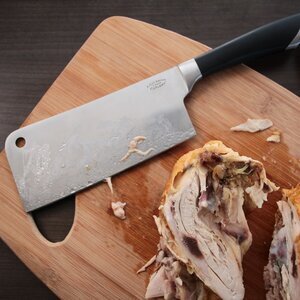
Cleavers, Aka butcher knives have flat, rectangular-shaped blades. They are available in various sizes but still, they are the widest and heaviest knives.
Sometimes they include a hole at the spine of the blade, to be used for hanging the tool.
A standard meat cleaver features a full tang, a thick spine, and a sharply beveled edge.
Read more , How to Sharpen your Knives Without a Sharpener? 9 Easy Methods!
What is the use of a cleaver knife or a butcher knife?
A cleaver is used to cut raw meat into smaller chunks before cooking. either as part of the butchery step or to break it into smaller pieces before cooking
This type of knife is typically used on raw meat rather than prepared meals due to its large size.
A meat cleaver may also be used to smash garlic cloves or ginger against a cutting board. Because of their broad, flat, hefty surface. (you might like to check our list of the best butcher knife set)
What is the best length for a cleaver or a butcher knife?
The total length of cleaver knives is usually between 10.5 and 12 inches. The blade edge measures 6 to 8 inches in length and has a circular hole on the top edge facing the handle. While The blade’s height ranges from 3 to 5 inches.
Boning knife
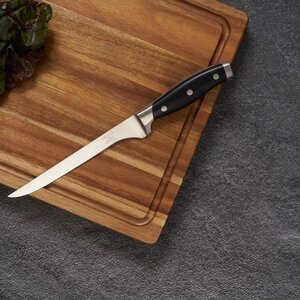
A boning knife is a thin blade with a razor-sharp edge that tapers to a narrow pointed tip. It is often short and stiff.
A boning knife is used for removing beef from the bone, filleting fish, and chopping up meat.
Smaller boning knives are used to peel and trim vegetables instead of a paring knife.
It is an ideal option for cutting around the bone without destroying the surrounding flesh. Due to its sharp tip and narrow blade. The stiff, robust blade is also used to split cartilage.
What is the best length for a boning knife?
Typically, boning knives are between 3 to 8 inches in length. With slightly different blade widths.
The blades can be flexible, semi-Flexi, or firm. Stiff blades are the most preferred by home chefs. Because of their enhanced precision of the cut.
Different types of knives for preparing fish
A fish knife is helpful for filleting, descaling, and separating bones from fish.
Different types of fish knives will make the process easier. Whether for slicing your sushi and sashimi or for grilling fish.
Also read , Forged Knives vs. Stamped Knives: What’s the Difference?
Fillet knife
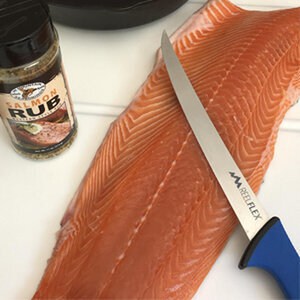
A filleting knife has a flexible, long, and thin blade.
It features a fine pointed tip and an extremely sharp edge for penetrating through the skin and bone-removing tasks.
It looks like a boning knife in appearance, with a slimmer and more adaptable blade.
What is the best length for a filleting knife?
The length of a fish fillet knife is often around 4 and 10 inches.
Smaller fish, such as trout, perch, or mackerel need 4 to 6 inches long blades
Salmon knife
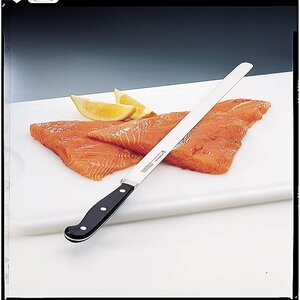
Salmon knives feature a long, adaptable, double-edged blade that is ideal for filleting bigger fish.
Salmon knives are thin and sharp for precision filleting and skin removal. And some versions have indentations down the blade’s side.
A salmon knife with a 7.5-inch blade is a perfect choice.
What is the use of a salmon knife?
A salmon knife is designed to cut, fillet, and remove the skin of bigger fish. It is thin enough to slide in between the skin and flesh of the delicate fish.
Many salmon knives feature dimpling or grooves along the side of the blade to minimize friction while cutting and to help prevent raw fish from clinging to the edges.
Santoku knife
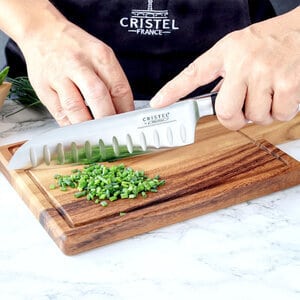
Originally known as santoku Bochco knives, which means “three uses”. They are the most popular kinds of Japanese kitchen knives.
A Santoku knife has a long and slightly curved blade with a drop point, making them excellent for precision cutting, dicing, and mincing.
What is the use of a santoku knife?
They are ideal for cutting fish or other raw seafood, because of their sharp, straight edges and drop-point tips,
They are also great for cutting vegetables. All in all a santoku knife is an excellent alternative for chef or utility knives.
A santoku knife comes in two sizes. One size is equivalent to a chef’s knife and mini-size like a utility knife. The 5′′ (12.5 cm) mini-santoku is ideal for small to medium kitchen cutting tasks.
Oyster knife
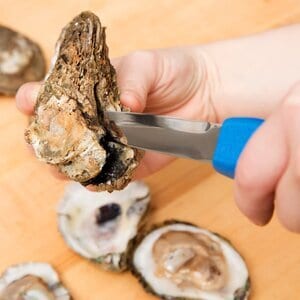
This is a knife for cracking apart the stiff shell of an oyster or shellfish.
The knife usually has a sharp, beveled blade to slip through the tightly sealed shell and force it to open. (check our list of the best oyster knives)
What is the best length for an oyster knife?
The blades of oysters knife do not need to be razor-sharp. Look for a 3-inch long blade constructed of corrosion-resistant metal.
Different types of knives for preparing vegetables.
Some chefs do cut vegetables with a chef or paring knife, while others invest in a specialty knife designed for vegetables only (and those are the pro ones!).
Let’s take a look at the types of vegetables’ knives.
Nakiri knife
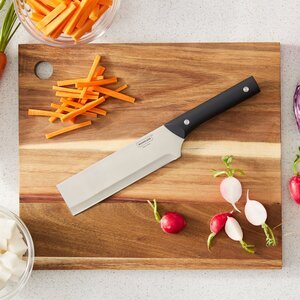
The Nakiri Bochco is a kind of Japanese knife used to cut vegetables. It looks like meat cleavers but smaller and sleeker.
A Naikiri knife has a wide, rectangular structure with a sharp hollow ground edge.
These knives should ideally have a blade length of no more than 7 inches
What is the use of a Nakiri knife?
Nakiri knives are practical utensils for cutting vegetables because they slice right through to the cutting board. With no need to rock the blade back and forth.
They are ideal for cutting larger and more difficult-to-cut vegetables, like sweet potatoes and butternut squash. And for shredding bigger vegetables such as cabbage or lettuce.
Tomatoes knife
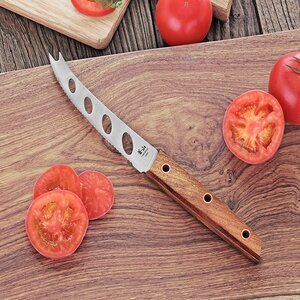
A tomato knife (aka serrated utility knife) is a compact serrated kitchen knife meant explicitly for slicing tomatoes.
The serrated knife helps the blade to pierce the skin of the tomatoes quickly and gently without squishing it.
Noting that, many tomato knives feature forked points that allow the user to move. And rearrange the tomato slices once they have been cut.
Various tomato knives feature grooved plastic or rubber handles, to provide a nice grip when cutting.
What is the best length for a tomato knife?
A tomato knife’s blade edge is generally 6–7 inches long. and is meant to be light and straightforward to handle.
Peeling knife
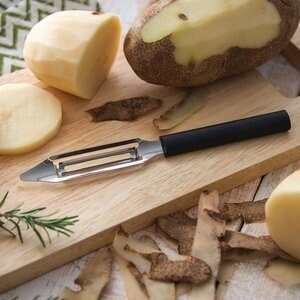
A peeling knife is often described as a bird’s beak, tourné, or trimming knife. It has a pointed tip that slopes downward, upward, and sideways towards the blade edge.
They are used to cut ornamental garnishes (such as rosettes or fluted mushrooms), slice delicate fruits, and remove skins and defects.
They are used to produce a tourné cut in carrots too.
The knife will not slip during peeling tasks, because of the stiff blade and solid, ergonomic grip.
What is the best length for a peeling knife?
The blade of a peeling knife is short, stiff, and slightly curved. It is always 3 to 4 inches long.
Different types of dinner table knives
A dinner knife is the most common type of table knife. It is generally made of metal or stainless steel, with a slightly serrated edge.
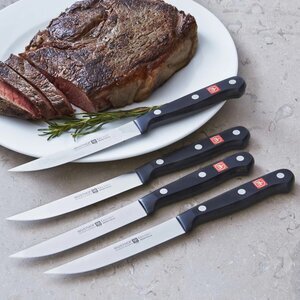
Steak knife
A steak knife is a table knife with a highly pointed tip and a serrated edge. It lets you slice through grilled meat or steak with ease.
Steak knife edges can be serrated, semi-serrated, or non-serrated.
Although serrated steak knives don’t need honing or sharpening, they stay sharp for years.
On the other hand, non-serrated knives get dull quickly. But sharpening them is a breeze using manual sharpeners or an electric sharpener.

Fish knife
A fish knife features a broad, flat blade with a sharp, curving edge. Its pointed tip makes it easy to remove tiny bones.
butter knife
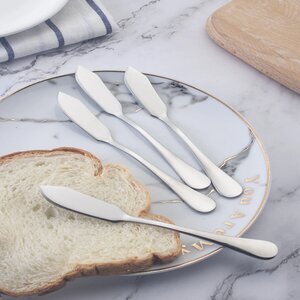
A butter knife has a wide paddle-like form and a soft, blunted edge. To help you distribute butter without scooping up crumbs or slicing the bread.
A Butterknife is important for buttering scones, English muffins, and sandwich bread.

Cheese knife
Cheese knives are designed to cut a variety of cheeses. (check our list of the best cheese knives on the market now).
Some of them feature small holes to prevent the cheese from clinging to the knife. And others feature sharper blades for tougher cheeses.
Final thoughts
Now you know what are the different types of kitchen knives and their uses, Don’t you? If we missed any type of knives, feel free to tell us about them in the comments below.
